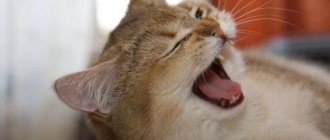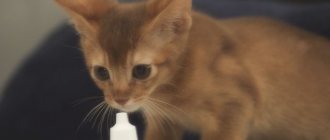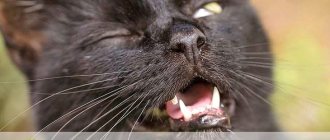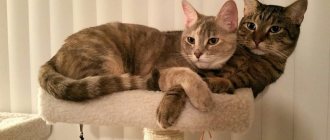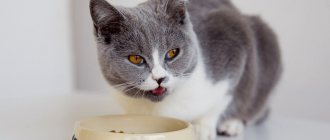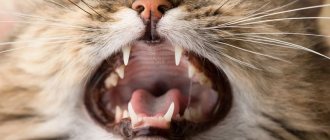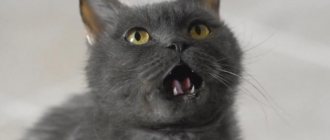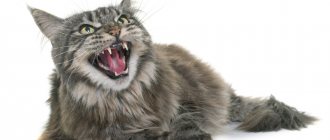13242Administration
1
Many owners often wonder why their cat sneezes and his eyes water. Some consult with a veterinarian, others try to overcome it on their own by washing the eyeball with herbal or tea infusions, while others hope that it will go away on its own.
Often the owner still pays attention to the fact that the animal is sneezing. If it sneezes due to dust particles getting into the nasal passage, then there is no need to worry. But when a runny nose and sneezing become permanent, it is necessary to figure out why the animal is sneezing and eliminate the disease.
Tears in animals perform a protective function, which is similar to the processes occurring in humans. Tears appear if dust or speck gets in. This is normal. But if the cat behaves restlessly and the flow of tears continues for a sufficient time, then this process must be stopped.
© shutterstock
If a cat’s eyes are watery and sneezing at the same time, then these are good reasons to seek help from a doctor.
Causes
What should you do if your cat sneezes and his eyes water?
Watery eyes and sneezing can occur either from ordinary litter or from a serious infection. Therefore, at the first symptoms, it is recommended to see a specialist.
The most common reasons why a cat's eyes are watery are:
Allergy . This phenomenon is quite common. Allergic reactions can be caused by various household products, perfumes, deodorants, pollen, mold, and even cat litter.
It often happens that a baby sneezes on his own fur , which ends up in various organs. Irritation and fluid discharge from the eyes can be caused by blood-sucking insects: mosquitoes and fleas.
In case of allergies, you need to find sources and methods to eliminate them.
- Conjunctivitis . Many bacteria and infections can cause inflammation of the organ mucosa. Conjunctivitis is accompanied by itching, the eyelids become swollen, and pus may drain from the eyes. With complex manifestations of this disease, fever may appear. The cat will be weak. There may also be a lack of appetite.
- Children's age of a cat . Strong production of tears is typical for newborn kittens who have opened their eyes for the first time. Usually the mother cat does the washing. But if she is not nearby, then the kitten’s eyes should be wiped with boiled water or an infusion of weak tea.
- Breed personality . There are special breeds of cats, such as Persians, Britons and Sphynxes, in which lacrimation occurs due to their anatomical shape of the eyes and structure of the skull. Such animals require careful care.
- Weakened immunity . Such cats are more often exposed to diseases and infections. Often with the following symptoms: sneezing, coughing, watery eyes. To strengthen the immune system and to never hear the animal sneeze, you should get special vaccinations and monitor the cat’s diet.
- Infectious diseases . The eyes are watery, the pet is sneezing - all this can occur with the following infections: chlamydia, calcivirosis, rhinotracheitis and others. Some of them are transmitted by airborne droplets, so the owner is at risk of becoming infected. To prevent various infections, as well as to avoid identifying the reasons why your friend is sneezing and his visual organs are watery, it is recommended to vaccinate the animal on time.
- Eye diseases . Of these, glaucoma and cataracts are well known. These are very serious illnesses that appear due to improper metabolism and can lead to loss of vision in a cat. In the early stages, the disease is quite easy to recognize. At a later stage, the cat’s vision decreases, the lens becomes cloudy, and lacrimation appears.
- Helminths . When cats develop worms, vomiting, diarrhea, lack of appetite, and excessive lacrimation are possible.
- Eye damage . If a cat has an injury in the area of these organs and they are tearing a lot, then it is necessary to inspect this area. If the wound is not severe, then simply treating it with Furacilin solution will help. For severe bruises, you should consult a doctor.
Treatment
Since a runny nose often becomes only an indicator of a viral infection or other inflammation in the body, it will be necessary to treat not so much it as the root cause.
It is not always possible to independently find out the true source of the disease. Therefore, it is very important to consult a veterinarian, carry out a diagnosis and follow the treatment plan
It will be very difficult to cure a stray cat from a runny nose if he is not provided with comfortable conditions: warmth, food, vitamins and scheduled medications.
Useful video on how to put drops in a cat's nose:
Colds and rhinitis
If your cat's cold cannot be treated at home, then you need to seek help from a veterinarian. The clinic will examine the cat and prescribe the necessary medications. It is not recommended to use medications without a prescription from a specialist. Typically treatment includes:
- Taking antipyretics if the temperature persists.
- Expectorants.
- Antibiotics.
- Vitamins.
- Droppers (to avoid dehydration).
- Maxidin. Drop into the nose to stimulate the immune system.
- Anandin. Antiviral and immune system stimulant.
- Naphthyzin together with Dioxidine. Nasal rinsing.
- Galazolin. Drops to ease breathing.
One drop of the drug is instilled into each nostril. The course is from five days to a week. You can rinse your nose with zinc sulfate (2%), boric acid (3%), a mixture of Methanol and fish oil.
Other means: “Maksidin”, “Derinat”.
Allergic runny nose
Irritation in animals is caused by food and non-food allergens. The most common of them:
- Beef or pork.
- Chicken, chicken eggs.
- Cow's milk.
- Corn, wheat (other cereal grains).
- Potato.
- Carrot.
- Dust.
- Mold.
- Hygiene products, household chemicals.
- Irritant from a flea collar.
To cure an allergy, you need to accurately and in detail describe the symptoms to the doctor; it is advisable to note what exactly the cat reacts to and for how long. They do a blood test and scraping. Antihistamines and corticosteroids are most often used for treatment.
The house needs to be treated with insecticides, and the animal must be isolated from the allergen that causes the reaction. If you cannot immediately find out what exactly is causing the disorder, you must remove as much as possible all household chemicals, medications, cosmetics, etc. The room must be cleaned and ventilated frequently.
If the allergy is accompanied by itching, the doctor will prescribe a special ointment, shampoo or gel. Sometimes steroid hormones and immunotherapy are prescribed (a small amount of the allergen is injected into the blood so that the body gets used to it).
If you have an eating disorder, you need to follow a diet. For example, use hypoallergenic food. When the symptoms go away, the previous foods are returned to the diet, checking the animal’s reaction. If the runny nose recurs, food allergens should be categorically removed from the animal’s food forever.
Viral runny nose
Among viral infections, rhinotracheitis, calicivirosis, mycoplasmosis, chlamydia and other infections cause a runny nose. And although they differ, the treatment regimen is approximately the same for everyone. The main thing is to contact specialists in time. You cannot cure a viral infection on your own; only a veterinarian can prescribe the exact dosage and duration.
Serum or globulin is used to create immunity - the drug VITAFEL, vitamins and probiotics, replacement therapy.
Antibiotics are required. They are drunk for at least five days, most often from a week to ten days, one to three times a day.
Treatment at home
For treatment at home, nasal drops are used, for example, children's nasal drops - one in each nostril daily. You can rinse your nose with a hypotonic solution: a teaspoon of sea salt in warm water (half a glass). The mucous membrane is also washed with a solution of tannin (0.5%), soda (1% solution). Streptocide powder is blown into the nasal cavity or two drops of ecmonovocillin are dripped into each nostril (it is diluted with saline 1:2).
From folk remedies, rinsing with beet juice is suitable: 1 part juice to 3 parts water. Aloe juice from the cut is collected into a pipette and dripped for three days. To rinse, you can use boric acid (draw the liquid into a syringe without a needle, drop it into the nostril).
You can do inhalation: take a bowl of hot water, drop eucalyptus or other oil into it, and place the container near the animal.
When is help needed?
If your animal has the following symptoms, then a trip to the veterinarian is required:
- the cat is constantly sneezing;
- his eyes are watering;
- no appetite;
- irritation and itching in the area of the visual organ;
- purulent discharge;
- the eyes became a different color and became cloudy;
- the animal is very lethargic or, on the contrary, overexcited;
- There are deep wounds and cuts.
The doctor will conduct an examination and prescribe the right treatment, thanks to which you will not hear or see your baby sneezing or his eyeballs watering.
What to do at home if a kitten sneezes?
The best thing you can do for your pet is to take him to a veterinarian, who will find out why the disease appeared. However, some owners try to treat their cat at home. Such help is reminiscent of playing roulette, because the owner does not know exactly what caused the illness.
The owner should be especially concerned if sneezing is combined with the following symptoms:
- bleeding from the nose;
- depressed state of the cat;
- elevated temperature;
- reduction in animal body weight;
- ulcers and rashes on the cat’s skin;
- profuse lacrimation;
- discharge of pus from the nasal passages and eyes;
- wheezing and whistling when breathing;
- cough;
- behavior change;
- vomit;
- diarrhea.
If your kitten is vaccinated, but begins to sneeze and exhibits alarming symptoms, most likely the cause is a simple cold or respiratory infection.
What to do at home so as not to harm your pet? Self-treatment always carries risks, but these will be minimal if therapy is aimed strictly at eliminating symptoms.
With the help of drugs
When an animal sneezes and its pupils are watery, the doctor suggests treatment with the following means:
- Anandin. This medicine helps in rapid healing of wounds and has antimicrobial effects;
- Maxidin. Has good immunostimulating properties. May help with inflammation of the eyes and rhinitis;
- Thymogen. This is a drug that regulates the immune system.
If no positive trends are observed, then, on the recommendation of a doctor and under his supervision, the following pills should be taken:
- Naphthyzin. It comes in the form of nasal or eye drops. Has the property of constricting blood vessels and has an antiphlogistic effect;
- Dioxidine. It is used for purulent rhinitis and has disinfectant properties;
- Derinat. Helps strengthen the immune system, used mainly for rhinitis and conjunctivitis;
- Nazivin. It comes in the form of drops: both for the nose and for the eyes. Used to reduce inflammation in these areas.
© shutterstock
If the cat has a serious illness, then the following medications are prescribed:
- Drops "Diamond eyes". They have an antimicrobial and regenerating effect thanks to components such as chlorhexidine, sodium succinate and taurine;
- Furacilin. It is contained in the drug "Bars", which fights microbes well. Novocaine, which is part of it, anesthetizes. Prescribed for severe keratitis;
- “Iris” is the name given to the drops that are used to treat a corneal ulcer. The composition contains the antibiotic gentamicin and many healing elements;
- To treat inflammation of the conjunctiva, Ciprovet is used, which contains the antibiotic ciprofloxacin.
Treatment
Since a runny nose often becomes only an indicator of a viral infection or other inflammation in the body, it will be necessary to treat not so much it as the root cause. It is not always possible to independently find out the true source of the disease.
Therefore, it is very important to consult a veterinarian, carry out a diagnosis and follow the treatment plan.
It will be very difficult to cure a stray cat from a runny nose if he is not provided with comfortable conditions: warmth, food, vitamins and scheduled medications.
Useful video on how to put drops in a cat's nose:
Colds and rhinitis
If your cat's cold cannot be treated at home, then you need to seek help from a veterinarian. The clinic will examine the cat and prescribe the necessary medications. It is not recommended to use medications without a prescription from a specialist. Typically treatment includes:
- Taking antipyretics if the temperature persists.
- Expectorants.
- Antibiotics.
- Vitamins.
- Droppers (to avoid dehydration).
Drugs used:
- Maxidin. Drop into the nose to stimulate the immune system.
- Anandin. Antiviral and immune system stimulant.
- Naphthyzin together with Dioxidine. Nasal rinsing.
- Galazolin. Drops to ease breathing.
One drop of the drug is instilled into each nostril. The course is from five days to a week. You can rinse your nose with zinc sulfate (2%), boric acid (3%), a mixture of Methanol and fish oil.
Other means: “Maksidin”, “Derinat”.
Allergic runny nose
Irritation in animals is caused by food and non-food allergens. The most common of them:
- Beef or pork.
- Chicken, chicken eggs.
- Cow's milk.
- Corn, wheat (other cereal grains).
- Potato.
- Carrot.
- Dust.
- Mold.
- Hygiene products, household chemicals.
- Irritant from a flea collar.
To cure an allergy, you need to accurately and in detail describe the symptoms to the doctor; it is advisable to note what exactly the cat reacts to and for how long. They do a blood test and scraping. Antihistamines and corticosteroids are most often used for treatment.
The house needs to be treated with insecticides, and the animal must be isolated from the allergen that causes the reaction. If you cannot immediately find out what exactly is causing the disorder, you must remove as much as possible all household chemicals, medications, cosmetics, etc. The room must be cleaned and ventilated frequently.
If the allergy is accompanied by itching, the doctor will prescribe a special ointment, shampoo or gel. Sometimes steroid hormones and immunotherapy are prescribed (a small amount of the allergen is injected into the blood so that the body gets used to it).
If you have an eating disorder, you need to follow a diet. For example, use hypoallergenic food. When the symptoms go away, the previous foods are returned to the diet, checking the animal’s reaction. If the runny nose recurs, food allergens should be categorically removed from the animal’s food forever.
Viral runny nose
Among viral infections, rhinotracheitis, calicivirosis, mycoplasmosis, chlamydia and other infections cause a runny nose. And although they differ, the treatment regimen is approximately the same for everyone. The main thing is to contact specialists in time. You cannot cure a viral infection on your own; only a veterinarian can prescribe the exact dosage and duration.
Serum or globulin is used to create immunity - the drug VITAFEL, vitamins and probiotics, replacement therapy.
Immunostimulants:
- Roncoleukin.
- Derinat.
- Neovir.
- Gamavit.
Antibiotics are required. They are drunk for at least five days, most often from a week to ten days, one to three times a day.
- Macropen.
- Baytril.
- Neopen.
- Cefazolin.
- and others.
Treatment at home
For treatment at home, nasal drops are used, for example, children's nasal drops - one in each nostril daily. You can rinse your nose with a hypotonic solution: a teaspoon of sea salt in warm water (half a glass). The mucous membrane is also washed with a solution of tannin (0.5%), soda (1% solution). Streptocide powder is blown into the nasal cavity or two drops of ecmonovocillin are dripped into each nostril (it is diluted with saline 1:2).
From folk remedies, rinsing with beet juice is suitable: 1 part juice to 3 parts water. Aloe juice from the cut is collected into a pipette and dripped for three days. To rinse, you can use boric acid (draw the liquid into a syringe without a needle, drop it into the nostril).
You can do inhalation: take a bowl of hot water, drop eucalyptus or other oil into it, and place the container near the animal.
How to carry out the procedure?
It is very important to hold the cat well with a towel during any medical procedure. Because any sudden movement of the pet can cause even more harm to it.
How to do it? First you need to prepare the place for burial. It is wiped with a cotton pad previously moistened with the necessary solution. Dried purulent discharge softens and is easily removed.
The next step is to take the following steps:
- prepare medications;
- pull back the eyelid;
- instill the drug;
- after penetration of the medicine, the cat should remain motionless for about 5 minutes for good absorption of the medicine;
- pet the cat and give him treats.
Why does a cat sneeze and watery eyes?
Many owners often wonder why their cat sneezes and his eyes water. Some consult with a veterinarian, others try to overcome it on their own by washing the eyeball with herbal or tea infusions, while others hope that it will go away on its own.
Often the owner still pays attention to the fact that the animal is sneezing. If it sneezes due to dust particles entering the nasal passage, then there is no need to worry
But when a runny nose and sneezing become permanent, it is necessary to figure out why the animal is sneezing and eliminate the disease.
Tears in animals perform a protective function, which is similar to the processes occurring in humans. Tears appear if dust or speck gets in. This is normal. But if the cat behaves restlessly and the flow of tears continues for a sufficient time, then this process must be stopped.
Traditional methods
If a cat is sneezing and his eyes are watery, then the owner may need folk remedies for his recovery. It is advisable that these measures be agreed upon with a veterinarian.
© shutterstock
The following folk methods can be used to treat the fact that a cat is sneezing and his visual organs are watering:
- Warming up. Place heated salt, collected in a bag, on the cat’s nose.
- Washing. Prepare a solution of salt or soda, fill a syringe with it and gradually spray it into the nostrils.
- Burial. Beetroot juice is good for this.
It is important to remember that treatment at home is a long-term process, but not complicated.
How to treat at home?
You can treat an animal at home if a veterinarian has conducted an examination, ordered the necessary tests and identified the true cause of the cat’s sneezing. Pet owners, when identifying an allergic reaction in their pets, often ask the question: what to do if the cat sneezes due to an allergy? In this case, the cat is prescribed antihistamines to alleviate its condition and eliminate the allergen.
If the cause of sneezing is polyps, then they can only be removed surgically in a veterinary clinic.
During an asthmatic attack, the animal is prescribed vasodilators, antispasmodics, and corticosteroids.
If the cause of sneezing is diseases of the teeth and gums, the animal’s teeth are treated, tartar is removed, inflammation of the gums is relieved, and vitamins are prescribed.
A parasitic cause in a cat is treated with special anthelmintic drugs, which will be recommended by a veterinarian. The owner is required to comply with the exact dosage and frequency of administration of the medicine to the animal.
How to treat if a cat is sneezing and has snot? This question is most often asked by owners of animals with a cold. The animal is prescribed anti-inflammatory drugs, nasal drops, and vitamins.
In the case of an infectious disease confirmed by laboratory tests, antibacterial and antiviral drugs, nasal medications, and immunomodulators are prescribed.
If you decide to treat your cat at home, then remember that this should be done based on the cause of the disease:
- Worms can be cured with special medications. Including Bothionol and Phenothiazine.
- Lysine is effective against sneezing caused by herpes.
- Mold allergies are treated with special ointments.
- If the cause is dental, the doctor will give the necessary recommendations and prescribe medications.
- Keeping your cat away from the source of your allergy, keeping your home clean, and monitoring your cat's activities will be an effective way to combat allergies.
Main problems
There are many conditions characterized by sneezing and watery eyes, but some are diagnosed more often than others. It is worth considering them separately. If other significant symptoms are present, pathology can be identified and treated.
How to tell if your cat has a cold
The cause of the disease is hypothermia of the pet. This is facilitated by a sharp temperature change. To do this, your pet just needs to play actively and then go outside during the cold season.
Swimming in cold water, jumping in the snow, and staying in the rain also contribute to the development of colds.
Characteristic features:
- cough;
- lethargy;
- conjunctivitis;
- temperature increase, but insignificant;
- lack of interest in food;
- snot.
Important! Cold symptoms are in many ways similar to other more serious pathologies, and if in doubt, you should visit a veterinarian and clarify the diagnosis. To recover, you need to provide your pet with peace, warmth and rest.
It is recommended to periodically rinse your eyes and nose with a cotton swab dipped in clean water at a comfortable temperature.
To recover, you need to provide your pet with peace, warmth and rest. It is recommended to periodically wash your eyes and nose with a cotton swab dipped in clean water at a comfortable temperature.
If the provoking factor is reduced immunity, then it is recommended to use vitamins and immunomodulators as agreed by the veterinarian. A cold goes away within 5-7 days.
Symptoms of laryngitis
The disease is characterized by inflammation of the mucous membrane of the mouth and larynx.
The cause of development is hypothermia of the throat
The cause of development is hypothermia of the throat as a result of eating cold food from the refrigerator or water, as well as after a long stay outside in winter or exposure to acrid smoke.
Symptoms:
- dry, hysterical cough, gradually turning into a wet one;
- swelling of the oral mucosa;
- foamy discharge from the mouth after a prolonged cough;
- restless sleep;
- wheezing.
To treat laryngitis, various medications are used depending on the cause of development. Only a veterinarian will prescribe an adequate course of therapy.
Attention! Laryngitis can be a sign of deadly viruses such as rabies, so you should see a doctor if these symptoms appear.
Rhinitis in cats
Rhinitis in cats
The pathological process develops against the background of hypothermia, allergies, parasites and various infections. At the same time, the cat has difficulty breathing and constantly opens his mouth.
Additional symptoms:
- inflamed lymph nodes under the jaw;
- sniffling;
- snore;
- dyspnea;
- snort;
- decreased activity;
- lack of appetite.
It is impossible to try to treat rhinitis without knowing the cause of its occurrence. This threatens to significantly complicate the situation and deteriorate the pet’s well-being. To prescribe therapy, consultation with a veterinarian is necessary.
At what time does rhinitis in pregnant women occur and how long does it last?
Most often, pathology occurs:
- up to the 20th week of pregnancy inclusive - in this case, rhinitis usually goes away on its own (in about a month or two) and does not manifest itself in later stages;
- after the 20th week of pregnancy - this condition can continue until childbirth and after it (after 2-3 weeks).
If the symptoms last longer than two months and are not relieved by any independent actions (vasoconstrictor sprays are prohibited for use!), then the cause may be hidden in a chronic disease.
What to do if your kitten starts sneezing frequently and his eyes are watery
First, pay attention to the behavior of the cat - if he periodically sneezes, his eyes are watery and often rubs his nose with his paw, this may indicate the presence of a foreign object in the nasal cavity
Carefully examine the kitten's nostrils and mouth - if you find any foreign objects or contaminants there, try to very carefully remove them using tweezers or small forceps. The main thing in this case is not to harm the poor fellow by damaging blood vessels or mucous membranes with careless movement.
The main thing is not to harm the poor fellow by damaging blood vessels or mucous membranes with careless movement.
If an external examination of the respiratory tract does not reveal the presence of foreign bodies in them, pay attention to whether mucus is secreted from the kitten’s nose. Its presence may indicate that the cat is sneezing and his eyes are watering due to an infectious disease or respiratory allergy
You can distinguish one from the other by determining the nature of this mucus. If the nasal discharge is clear, the cat most likely has an allergy; if the snot is gray or green, this may indicate that he is sneezing due to an infection.
